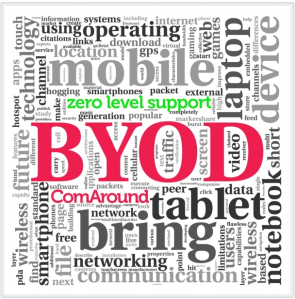Bring your own device (BYOD) is going to revolutionize the way technology is looked upon, but what is BYOD? It refers to rules and procedures set by the practice allowing employees to use their personal mobile gadgets to access company data. It can improve coordinated care because it reflects future of the healthcare industry.
Mobile devices are becoming common by every passing day. Mobile revolution is by all means is here and roaring. Practices’ use of smartphones and other gadgets is a common practice now.
A recent global survey conducted by PEW research of companies all around the world found that 28% of their workforce uses personal devices for work related tasks. The research further stated that this percentage is expected to rise to 35% in 2013. In general as of May 2013, 91% of American adults have a cell phone, 56% of American adults have a smartphone. This boils down to the fact that technological gadgets are extremely common, and using them in a work environment can not only be useful, but may very well generate a new market for employees in a work environment.
It can improve coordinated care because providers, nurses, healthcare staff and patients are generally more comfortable with their own devices as they have more control over it. Think of it like this, if a provider uses a mobile EHR device on his own smartphone, isn’t it convenient? It is way more efficient since he can take his device anywhere he likes and keep his practice in check.
BYOD can increase patient safety and reduce the risk of medical errors. Personal devices can patch the critical communication gaps and allow for easy access of clinical information at the point of care with other clinicians for coordinating care of the patient.
To provide security for all personal gadgets of the employees can become a huge challenge for the IT department of the healthcare facility but at the end of the day, standardization is also an issue. But look at this way, new rules, regulations and structures that are being formed will pave the way for innovation. It will provide coordinated care to their patients by allowing wide and convenient access to the patients. Apart from that, the sooner the challenges met in terms of diverse use of mobile devices the better it is, because in the future more and more unique personal devices will be produced.
Personal devices do not need to be set up in a certain way to function, instead the devices allows limited functionality. Downloading healthcare mobile EHR app from the store or accessing company’s email from your email browser doesn’t require using company services that are set up in a restrictive way. It essentially saves the setup cost.


